










Senior administration blamed by student groups for favouring the privileged
M eghrig M ilkon Senior News Editor
The future of graduate students remains in the dark.
In a letter addressed to the University on Sept. 19, the Society of Graduate and Professional Students (SGPS) expressed concern over the Senior Leadership Team’s (SLT) recent decision to cut the Queen’s Graduate Award (QGA) for incoming Master’s students starting next fall.
While the cuts don’t affect all Masters funding as supervisors and programs can still provide financial support, this move, part of a broader response to the University’s operating budget deficit, is

set to eliminate $4,100 per student toward research Master’s beginning next fall. The elimination of Ontario Graduate Scholarships (OGS) funding is expected to disproportionately impact equity-deserving groups,
Two years after her death, students reflect on the ongoing fight for women’s rights in Iran
M eghrig M ilkon Senior News Editor
The Iranian Association of Queen’s University held a commemoration on Monday, Sept. 16 marking two years since the death of Mahsa Amini on Sept. 16, 2022.
While visiting her family, 22-year-old Amini died in the custody of the Islamic Revolutionary Guard Corps after being arrested by the Islamic Republic’s morality police for wearing her hijab too loosely.
“[The Islamic Republic’s morality police] have been

controlling women and enforcing religious dress codes using intimidation tactics and abuse for the past 45 years,” an event speaker said.
Amini’s death was the ignition to the Woman, Life, Freedom movement, which gained momentum in Iran and globally. The commemoration, held in Mackintosh-Corry Hall, included a documentary screening, speeches, and Iranian poems read by students. The commemoration concluded with a candle-lighting ceremony to honour the women affected by the ongoing struggle.
The documentary, How Mahsa Aminis death sparked the hijab protests that changed Iran by public affairs program Foreign Correspondent highlights the first-hand experiences of women and families living in Iran under a government that imposes many restrictions on women’s daily lives.
“I think this [her death] was

including first-generation graduate students and those facing financial hardship, the letter stated.
The letter urges Master’s students to share their stories about how the lack of funding—specifically, how a $4,100 reduction in stipends—would affect their ability to pursue or continue their studies.
“These cuts to Masters funding are an attack on the working class. What it does is it ensures that only people who either secure private or public funding or who already have the means to pay for an entire graduate
another part of the wake-up call for so many Iranians, especially Irani women, who realized that if Mahsa could lose her life, simply for existing, that none of them were safe,” the same student said in their speech. “To give up is not an option when the fight inside Iran continues every day when a girl leaves her house without her mandatory hijab, not knowing who she would encounter that day.”
Women in Iran face legal discrimination in personal status matters, including marriage, divorce, inheritance, and decisions involving children. Under the civil code, husbands can dictate where their wives live and prevent them from holding certain

education themselves can attend Master’s program,” PSAC 901 President Jake Morrow said in an interview with The Journal Morrow emphasized these cuts benefit only the privileged and harm those from underprivileged and marginalized backgrounds, calling the policy discriminatory and despicable. Morrow believes Matthew Evans is the “hatchet man,” and blames senior leadership—namely, Principal PatrickDeane—forcausinggraduate students’ instability in their studies.
SGPS on page 2
occupations if deemed contrary to “family values.”
The Passports Law restricts married women from obtaining passports or traveling without their husband’s written consent—this consent can be revoked at any time. The civil code allows girls to marry at age 13 and boys at age 15 and at younger ages if authorized by a judge, according to Human Rights Watch.
Cases of femicide are increasingly reported in media and social media, but Iran has no law on domestic violence to prevent abuse and protect survivors. As reported by Shargh and based on official

A id A n M ich A elov Senior Sports Editor
Marking the halfway point of the regular season, the Gaels defeated their historic rival 48-20, the Ottawa Gee-Gees, on Sept. 14 in Ottawa, recording their 500th all-time win.
The Gaels first took to the gridiron in 1882, since then they’ve been a pioneer leading the way for other football programs nation-wide to look up to, and chase in terms of legacy and prestige.
For Head Coach of the Men’s Football team, Steve Snyder, the win was more than just an achievement for those who played on the team.
“Anytime you can win a football game, it’s a good feeling. But when you put a bunch of history on top of it, and you’re able to share it with all the people that have played a part in the past that have helped us accumulate to this point, that’s really what 500 was all about. Celebrating the alumni and all the fans,” Snyder said in an interview with The Journal Queen’s has beenc competing against the Gee-Gees since 1889. After winning their last eight games against the grey and garnet, there was pressure to secure the 500th win on the road.
The Gaels came out flying in the first quarter, recording three touchdowns, with the first coming from young phenom Iain St. Arnault, ArtSci ’27, who returned yet another missed field goal attempt—making this his third returned field goal attempt in just two games. Football on page 10
statistics, at least 165 women in Iran were killed by male family members between March 2021 and the end of June 2023, an average of one killing every four days. From mid-March to mid-May of last year, so called “honour killings” saw 27 women reported as murdered—killings of women and girls perpetrated by family members.

Funds will be used to address growing patients’ needs
Jonathan Reilly Assistant News Editor
Kingston Health Sciences Centre (KHSC) received $17.5 million in funding—an investment aimed at supporting existing medical services.
The KHSC encompasses both Hotel Dieu and Kingston General Hospital (KGH), offering a wide range of services necessary for supporting Kingston and broader Southeastern Ontario communities.
In an interview with The Journal, Jason Hann, KHSC’s executive vice president, patient care and chief nursing executive & regional vice president of cancer care, stressed the importance of the Centre’s role in providing care to this broader population.
Kingston Health Sciences Centre receives an additional $17.5 million in funding
“As an organization, we’re Southeastern Ontario’s hub for complex, acute and specialty care. With this, we’re a leading research and teaching hospital and we provide vital services to over 650,000 people from southeastern Ontario, as far north as James Bay in Northern Ontario,” Hann said.
Hann emphasized KHSC is a particularly important health service as they provide specialized services which aren’t available at other hospitals in the area.
“We offer advanced medical care, which is not available in our local communities. Some examples would be heart surgery, brain surgery, radiation therapy for cancer and advanced imaging, which includes CAT scans, MRIs, and vascular imaging. We’re [KHSC] the only hospital in the region that can provide that care,” Hann said.
The $17.5 million in funding for KHSC has been divided amongst four main areas, the biggest of which is $9.7

Continued from first page.
The letter argues the policy contradicts Queen’s Educational Equity Policy, which acknowledges systemic barriers disadvantage certain groups based on social identities such as race, ethnicity, disability, gender identity, sexual orientation, and socioeconomic status. It also points out undergraduate students already graduate with an average debt of $30,600.
The financial burden on students is a top concern for SGPS President, Emils Matiss who said addressing food insecurity has become a higher priority for the student union than ever before.
“We’ve been investing more in food insecurity measures, and personally, this is incredibly troubling for me because we’re not a food bank. We’ve learned from members that this is the best way we can help them. Reducing the OGS would make it much harder for students to support themselves,” Matiss saidin an interview with The Journal.
Another concern raised in the letter relates to recruiting and increasing graduate student enrolment as about one-third of PhD students start their academic journey at Queen’s as Master’s students. Matiss argues the
proposed cuts are counterproductive for this goal, as they would likely reduce teaching opportunities at Queen’s and harm the University’s competitiveness in securing research funding.
“Reducing master’s student funding would also have wider implications. It could lead to a decline in enrolment, which would in turn, reduce our allocation of OGS and Queen Elizabeth II Graduate Scholarships in Science and Technology (QEII-GSST). Thiscouldharmourcompetitiveness for Tri-Agency funding, with potential consequences for our research output and reputation,” Matiss said in the letter.
Tri-Agency includes the three Canadian Government research funding agencies, including the Canadian Institutes of Health Research (CIHR), theNaturalSciencesandEngineering Research Council (NSERC), and the Social Sciences and Humanities Research Council (SSHRC).
Matiss said the letter is not a critique of the “need for fiscal responsibility,” but rather the strategies in which undermine Queen’s “values of equity and excellence.”
million from the Growth and Efficiency Model (GEM). GEM provides funding based on how well an organization is running, with more efficiently run organizations getting more in funding.
Hann detailed the steps KHSC took to secure the funding and highlighted the key issues it aims to address.
“What we’ve demonstrated is that we’ve grown, increasing our volume and providing more care, but we’ve been able to do that while keeping our costs down, so we’re efficient. This money helps support the increasing volumes and the cost of inflation,” Hann said.
Another $1.4 million will be used to fund KHSC’s cardiac program, allowing them to “increase our number of cardiac beds in our cardiac intensive care unit” as well as increase the amount of “critical care beds as well as in-patient beds.”
Another $2.6 million will be used to fund MRI and
CAT imaging, aimed at reducing wait times for these scans.
These funds come alongside another $3.8 million being put towards infrastructure needs such as general upkeep, elevator repairs, and masonry work. The funding will additionally allow KHSC to focus on the research and training aspect of KHSC.
“KHSC plays a significant role in educating healthcare professionals. We train thousands of students annually, from nurses, allied health professionals, medical students, and hundreds of researchers that are dedicated to making groundbreaking advancements in healthcare,” Hann said.
Looking ahead, Hann recognizes the potential challenges posed by Canada’s aging population and aims to address them through ongoing growth and an expansion of their facilities.
Kingston will have 13 new electric buses, improved infrastructures, and shelters
Meghrig Milkon Senior News Editor
An $83 million combined investment is gearing up to spark a new commuter culture in Kingston.
Four Eastern Ontario communities are joining forces to revamp their public transit systems. Approximately $25 million comes from the Government of Ontario, with the remaining approximate $28 million being contributed by the municipalities of Cornwall, Kingston, Peterborough, and Trent Hills. The project involves purchasing longrange battery electric transit buses and installing auxiliary and accessibility equipment.
The federal government is contributing $30 million through its Public Transit Infrastructure Stream as part of the Investing in Canada Infrastructure Program to support 18 public transit projects.
Backed by all three levels of government—federal, provincial,
and municipal—Kingston Transit is set to add 13 electric buses to its fleet, improve pedestrian and cyclist infrastructure, upgrade sidewalks, and construct new transit stations and bus shelters, the Government of Canada announced on Sept. 12.
Key players, including Member of Parliament for Kingston and the Islands, Mark Gerretsen, Member of Provincial Parliament for Hastings—Lennox and Addington, Kingston Mayor Bryan Paterson, and Cornwall Mayor Justin Towndale, came together on Sept. 12 to announce this significant investment in public transit.
“This is fantastic news for Eastern Ontario! Investing in public transit infrastructure is an investment in our communities. Expanding transit options helps people get to work, school, home, and essential services, making our communities stronger,” Gerretsen stated in a press release.
Since 2015, the federal government has committed over $30 billion to public transit and active transportation projects. According to the Government of Canada, these historic investments have led to nearly 2,000 projects nationwide.
The federal government explained this investment in the City of Kingston will
allow the construction of 12 transit passenger stations and 44 bus shelters at already established bus stops. Locations regarding these stations and stops are not yet available.
“This investment, in collaboration with our federal and provincial governments, is not just about improving our public transit system—it’s about creating a more sustainable, connected and vibrant community,” Mayor Bryan Paterson said. “Electric buses and enhancing our infrastructure, we are building a city that puts people first, reduces our carbon footprint and fosters greater mobility for all.”
Continued online at www.queensjournal.ca
Pro-Palestine walkout demands Queen’s divest from companies and corporations connected to Israel
A previous version of this story mistakenly stated the speaker’s grandparents were “Brazilian” instead of “resilient,” and omitted Queen’s students have the privilege of “education” within the same speech.
The Journal regrets the error.
Grant will fund student mental health supports and literacy courses at the U-Flourish Centre
Lauren Nicol Assistant News Editor
The U-Flourish Centre is seeking a £7 million grant to advance research on early intervention for worsening mental health, positioning itself as a global competitor.
Originally starting as a research project launched by the Department of Psychiatry, the centre began with a $30,000 grant in 2018 and has since received ongoing donations. Last year, the centre received a $2.875 million donation from the Rossy Family Foundation to enhance the mental health literacy curriculum at Queen’s and formally establish the centre. Now, U-Flourish is seeking an additional grant to enable the University to work on accelerating early intervention of worsening mental health and developing digital resources for students.
Dr. Anne Duffy, a child and adolescent psychiatrist with specialized training in mood disorders, is a full-time

member of the Department of Psychiatry, Division of Student Mental Health at Queen’s. Her research focuses on the onset of common mental illnesses and is the U-Flourish Centre Director. Her position involves overseeing and facilitating both national and international research initiatives.
“We’re becoming the lead around the world in university student well-being in mental health now. We would really like to move forward,” Duffy said in an interview with The Journal.
An initial U-Flourish survey, beginning with the 2017-18 cohort, used rigorous research methodology and was designed as a “digital conversation” with students to translate their needs into evidencebased resources. The survey was taken by 60 per cent of all
first-year students.
“We had about 3,029 [total] students who started a conversation with us, and we followed up with them at the end of the year,” Duffy said. “Ever since then, we’ve continued this longitudinal survey, following up, continuing to follow those students to graduation, and continuing to engage a new cohort of incoming students to Queens.”
The study was eventually emulated in five United Kingdom Universities, including the University of Oxford where Duffy was invited as a visiting professor to enact the study there.
Given its global engagement and connection with United Kingdom academic institutions, U-Flourish is
competing with other overseas institutions for the highest bid on the grant.
Duffy describes the U-Flourish Centre as “a seamless journey for any student who needed any level of support from education to health promotion to seeing a family doctor for a mental health concern to seeing a psychiatrist.”
While most students will not experience serious mental health issues, it’s common for students to experience stress inducive to difficulty in their academic lives, Duffy explained.
Queen’s, through the 2023 release of U-Flourish, was able to release a wellbeing platform that includes a student well-being calculator where you can enter your information and receive immediate feedback on your mental health and how you can improve it.
“[Students] told us that they love the [IDIS99] mental health literacy course. They love the fact that they can get credit for taking this as an interdisciplinary elective, and they found it very practical, student tailored and interesting,” Duffy said.
Duffy emphasized student participation was key to the initial and future U-Flourish investments and none of this would be possible without collaboration with students and the University.
Students make memories with participants with Down Syndrome
Jonathan Reilly Assistant News Editor
Building on an awardwinning year, AMS club Extra Awesome is looking to be exactly what its name is.
The student club works in collaboration with the Down Syndrome Association of Kingston (DSAK) to plan events primarily for those with Down Syndrome, but also those with Autism, aimed at facilitating skill development and fun. Extra Awesome was the recipient of the AMS award for new club of the year.
Beginning as a volunteer and session programmer, current Co-Chair Emma Wiggins, HealthSci ’25, emphasized the club’s approach to inclusivity.
“We look to support the development of social and motor skills through play-based learning and the
establishment of friendships with Queen’s student mentors, and [to] increase inclusivity through advocacy via education campaigns and events,” Wiggins said in a statement to The Journal.
Training volunteers is an important part of the club’s operations, focusing on “personfirst language, avoiding patronizing language and conduct, training on strengths and weaknesses of the disabilities we work on, and preparation on how to adapt activities for specific variable needs,” Wiggins said.
The club hosts one-hour events weekly where participants visit Queen’s campus and partake in events such as karaoke, dancing, and charades, along with rotational activities where participants do crafts, puzzles, matching games, and more.
“This year we hope to sell some things including DIY mismatched socks for World Down Syndrome Day and other things made and decorated by our participants,”
Wiggins said.
On Sept. 21, Extra Awesome is partnering with Queen’s Football so participants can take a trip to Richardson Stadium, pass on the field with the team and talk with players.
To “increase inclusivity”, Extra Awesome makes weekly posts on social media for “Terminology Tuesday” to explain terms used surrounding disabilities that are misunderstood or misused, such as person-first language, invisible disabilities, and more.
Person first language is defined as “Using language that puts the person before their diagnosis to emphasize that they are humans and should not be defined by their disability,” according to the club’s Instagram story.
Invisible Disabilities are defined as “any disability that is not immediately noticeable by bypassers. This includes people with brain injuries, chronic pain, mental illness, and more.”
Extra Awesome also partakes in collaborations with other AMS
Schoolwide email urges neutrality as pressure mounts for the University to issue political statements
Meghrig Milkon Senior News Editor
As conflicts continue to escalate, particularly in the Middle East, Principal Patrick Deane expressed the institution’s inability to take a stance
In a schoolwide email sent on Sept. 19 just before noon, Deane outlined Queen’s position on commenting on both global and domestic affairs. He emphasized the University, as a diverse institution, promotes understanding through research and dialogue.
Deane acknowledged heightened conflicts often elicit strong emotions due to “personal, moral, or ethical conviction[s],” especially for those with family or friends directly impacted.
“The pressure to comment or adopt a position can be considerable, but the university, by definition and mission, is a diverse plurality: a large community that includes many different perspectives, which the institution considers and evaluates through dialogue and research,” Deane stated.
He affirmed while individual members of the Queen’s community are encouraged to express personal views, the University itself cannot do so. He highlighted the institution’s commitment to principles of “free and open enquiry,” consistent with the Chicago Principles and the Magna Charta Universitatum to which Queen’s is a signatory.
groups, such as their annual fundraiser with Common Ground Coffeehouse, where participants show off their singing and dancing talents to an audience during an open mic event.
Wiggins said the open mic is one of their annual fundraisers which is necessary for Extra Awesome to operate without charging participants. To keep activities free, the club collaborates with local businesses like SpinCo and Campus One Stop on raffles and donations.
Deane also noted while other universities may take different approaches, Queen’s will limit institutional statements to matters directly affecting the University.
“With these considerations in mind, Queen’s is adopting a standard practice of not issuing university statements that take an institutional position on global or domestic affairs. Faculties and departments are asked to mirror this approach,” Deane said.
Interested in contributing to The Journal? Email journal_editors@ams.queensu.ca for more information. No experience is necessary.
Faculties and departments are encouraged to maintain this stance, ensuring academic freedom is upheld while fostering respect and open debate. Deane also reminded faculty to distinguish their personal views from official university positions when making public statements.
“Together, our community can continue to foster a respectful and inclusive environment where ideas can be expressed and explored with openness, tolerance, and academic rigour. Your support in this matter is greatly appreciated,” Deane stated.
Faculty seats increase from 29 to 34 with some faculties not receiving an increase in seats
Lauren Nicol Assistant News Editor
Changes come to AMS Assembly for the 2024-25 year as the AMS increases the number of seats for some faculties, but not all.
On Aug. 16, the AMS issued a news release detailing an increase in faculty seats on AMS Assembly, the highest undergraduate legislative body with representation from different faculties. The AMS states these changes were decided based on enrollment numbers from the winter semester, and the increase of seats was ratified by the President’s caucus on July 30.
The AMS Assembly acts as a governing body for all undergraduate students with representatives to advocate for the students from each faculty.
“AMS Assembly strives to be an equal representation or equitable representation of students across faculties. So, this decision was made to ensure we maintain representation and can keep assembly to be the most productive,” said AMS President Owen Rocchi in an interview with The Journal.
The Arts and Science Undergraduate Society (ASUS) will be allocated three more seats from last year moving the total to 10, while
the Health Science Society (HSS) will have an increase of one seat to a total of three. Queen’s Nursing Science Society (NSS) seats will be increased to a total of two with an increase of one.
No other faculties will receive an increase in seats.
Rocchi said all faculty societies advocated for their students and many wanted to receive an increase in representation at Assembly.
The AMS made the decision to increase seats in proportion to the number of students that each faculty represents. This is in accordance to the AMS Constitution which states in section 5.1.7, “the AMS Assembly strives to have a ratio of 500 students per one seat filled at the Assembly.”
“One of the main reasons we felt okay with increasing
the number of seats from 29 to 34 for this year is that we can be closer to that 500 to one student representation on Assembly, among other reasons,” Rocchi said.
“[Faculty societies are] all very passionate about having as much representation as possible at Assembly as it is the ultimate governing body of the AMS and the voice of the undergraduate student body. I think the general sentiment was that they just wanted to be able to have more of a presencebut,throughconversations, we were able to settle and agree.”
Rocchi said he appreciates the eagerness of faculty societies to have representation.


Liam
a
Meghrig Milkon Senior News Editor
Queen’s University sorrowfully says goodbye to a valuable student and athlete.
Liam Horton, born and raised in Toronto, was a PhD student in the Smith Faculty of Engineering and Applied Science.
One of three Horton brothers, he was deeply loved by family and friends. When he passed away on Aug. 29, he left behind countless individuals who were inspired by him.
“He had a warm smile, infectious enthusiasm, and unwavering dedication to helping others. His energy, intelligence, and generosity were gifts he shared freely. Driven by a quest for excellence, he took on every challenge with unrelenting determination,” the Gazette said.
Horton earned his first degree, a Bachelor of Applied Science in Mining and Mechanical Engineering (Mine Mechanical Option), from Queen’s. He later pursued a PhD in Engineering with a focus on Mechatronics and Robotics. His research was centred on integrating Unmanned Aerial Vehicles (UAVs) into the bridge inspection process, enabling automated data collection and real-time AI-based screening and decision-making for existing infrastructure.
Horton, known for his academic excellence, earned numerous awards

and scholarships in recognition of his outstanding performance. He was also the leader of both the Queen’s Varsity Mens Wrestling team and the Kingston & Area Olympic Wrestling Club.
“He was a Dean’s scholar, awarded with the prestigious Medal in Mining Engineering, was a two-time recipient of the R.S. McLaughlin Fellowship, and awarded the highlycoveted Alexander G. Bell Canada Graduate Scholarship,” the Gazette stated.
Horton’s tragic and accidental passing has left many in profound pain and grief. He was known for his boundless energy, intelligence, and generosity, always willing to share these gifts with the world.
The visitation will be held on Friday, Sept. 20, from 4 to 8 p.m. at Turner & Porter Yorke Chapel, 2357 Bloor St. W., Toronto. A service honouring Liam’s life will take place on Sept. 21, at 1 p.m. at the Royal St. George College Chapel of St. Alban, 120 Howland Ave., Toronto.




Sarah Adams Features Editor
Keara’s pulse quickened as the incessant click-clickclick of pens in the lecture hall felt like nails on a chalkboard. Each tap-tap-tap of typing in the library sliced through her focus, and even the faintest crack of knuckles or rustle of food seemed to pierce her nerves. Every noise, from the clinking of silverware to the crunch of snacks, turned her quiet study time into a relentless slap to her senses.
“I struggle daily with misophonia,” Keara Watson-Laird, ArtSci ’26, said in a statement to The Journal
“People with misophonia are affected emotionally by common sounds—usually those made by others, and usually ones that other people don’t pay attention to,” author James Cartreine, PhD, said in Havard Health Publishing.
Anything from breathing, yawning, or chewing can create a fight-or-flight response, triggering anger and a desire to escape, Cartreine said.
In March 2023, a study conducted by the University of Oxford revealed misophonia is a much more common phenomenon than most people realize, where one in five people struggle with tolerance of everyday sounds.
A June 2018 study conducted by the National Institute of Health investigated the incidence, correlations, and impairments associated with misophonia in a student population. Results indicated out of 483 undergraduate students, 22.8 per cent were always sensitive to, or annoyed by specific sounds.
Misophonia has a presence in education institutions more than some might realize.
“Based on my experience, I would define sound misophonia as auditory elements that agitate or upset the listener,” Watson-Laird said. “My instinct is to flee, to try and get as far away as possible from the sound.”
Watson-Laird reflected on her challenges, such as doing poorly on in-person tests. With small, distracting sounds often breaking her concentration, she struggles to regain focus.
In a meeting with her Queen’s Student Accessibility Services (QSAS) advisor back in her first year, Watson-Laird was given the option to write exams in smaller rooms so triggering sounds wouldn’t be as prominent. However, she struggles more with everyday life outside of exams.
Every sound feels like a personal invasion, turning the world into a battleground where silence is the only refuge, she said. Lecture halls and campus libraries serve as primary catalysts.
“I sometimes wear noise cancelling headphones in class because I can still hear the professor’s voice but not the provoking sounds—I’ve been told to remove them multiple times,” Watson-Laird said. “A lot of people don’t understand
how upsetting and psychologically distressing having misophonia is—where people often don’t treat it seriously.”
Watson-Laird is no stranger to having friends, and even professors chuckle when she tries to explain how awful misophonia can be.
The negative experiences faced by students with misophonia have had weighing consequences on other aspects of their mental health. For Watson-Laird, the irrational anxiety that develops from being subjected to such uncomfortable sounds can be serious.
“It’s not a joke,” she said.
“In the last four or five years, there’s been more emphasis on mental health and there’s been more people suffering from mental health probably because of all the things that have been going on—at least in the States—in terms of the pandemic, our political turmoil, economy and all those things,” Dr. Lousie Goddard said in an American Medical Association publication. “There’s more of that going on and with more awareness, misophonia becomes more visible.”
As libraries echo with laughter and conversation, the struggle for students with misophonia is a poignant reminder that silence can be a privilege. The daily struggles faced by students with sound-triggered sensory issues akin to Watson-Laird reflect a bigger picture of what universities could be doing to better support students through their battles with sounds.
“Other than the opportunity to write my exams in smaller classrooms, not much aid has been offered—with my personal aids having been rebuked,” Watson-Laird said.
Nonetheless, the third-year student contends smaller classrooms aren’t always the solution.
Watson-Laird echo’s Dr. Goddard’s sentiment on how the empirical prevalence of misophonia as a mental health phenomenon calls to action the possibility of universities adjusting and developing better resources to accommodate students.
The QSAS Vision & Mission statement focuses on creating universally inclusive and accessible educational experiences that foster independence and autonomy for all students with disabilities through developing ongoing partnerships with students, faculty, and staff.
QSAS is directly involved in working with students to create accommodations that remove barriers, develop long term plans to support students, create letters of accommodation, and help support students navigating the accommodation system.
On the other hand, the scope of mental health services in respect to Queen’s Student Wellness Services (SWS) is a limited, short-term care provided
‘My instinct is to flee, to try and get as far away as possible from the sound’
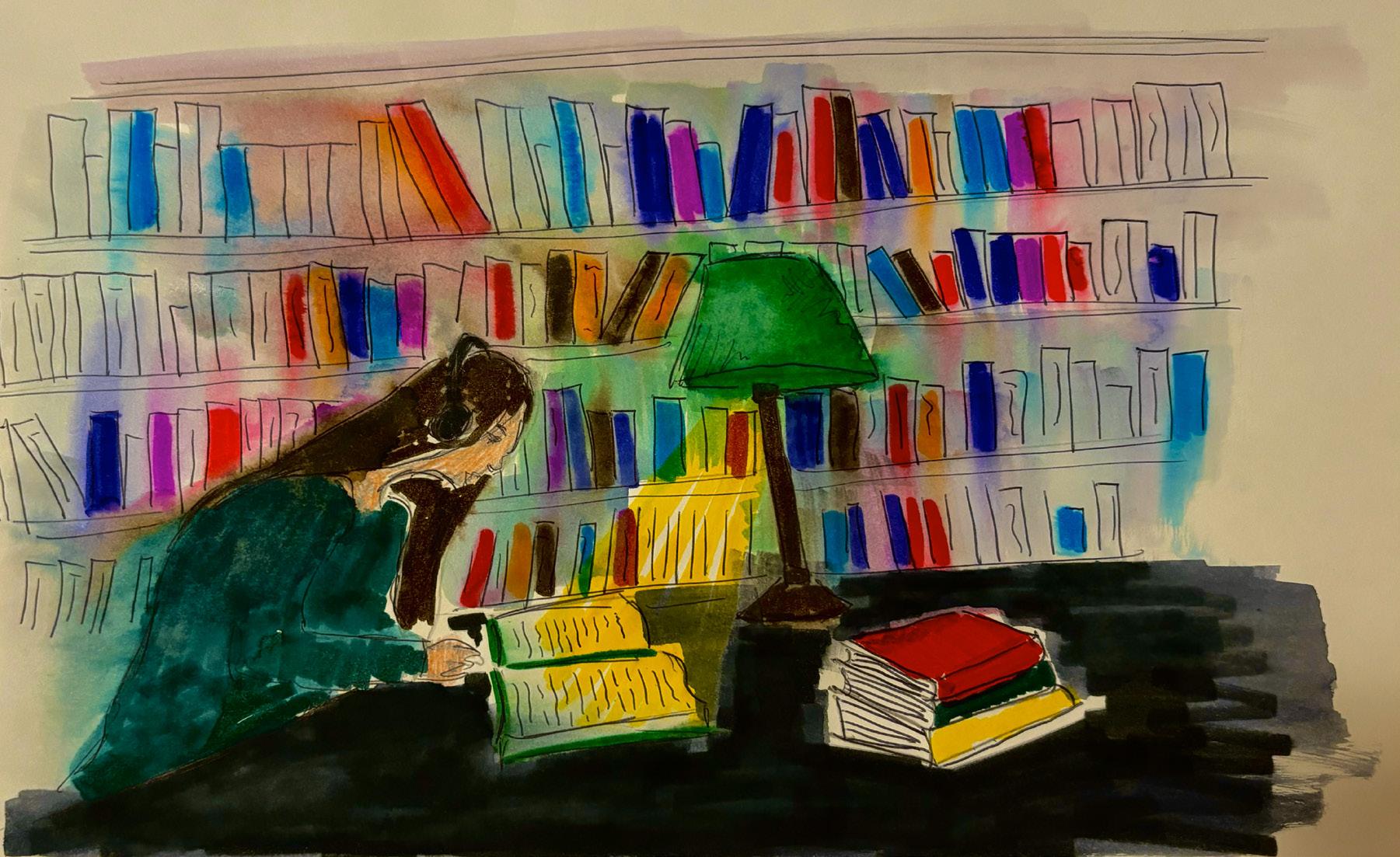
for students needing to access mental health services.
The more restricted range of SWS care means it’s unable to provide accessibility solutions for misophonia, as well as regular appointments with a psychiatrist, treatment for complex mental health diagnoses as these require specialists, care plans, and supervision.
QSAS employee, Dr. Anne Duffy, declined the opportunity to speak about misophonia with The Journal due to the topic being “outside their scope of research.”
Watson-Laird suggests that a potential solution for her and other students struggling with misophonia is to allow school-approved noise-canceling headphones as accessibility aids during exams which can be “so helpful for people with auditory difficulties.”
Technological institutions are in the process of working to support individuals with misophonia. The researchers at the University of Washington in Seattle have developed Aritifical Intelligence (AI)-assisted headphones with real-time sound filtering capabilities, the Centre for Accessibility Australia reported.
This technology, known as semantic hearing, is designed to help individuals with sensory conditions like misophonia by enabling users to selectively filter out specific sounds while allowing others to remain audible.
“The innovation of AI-assisted headphones opens up new possibilities for managing Misophonia and similar sensory issues—by leveraging advanced algorithms, these headphones can identify, isolate, and suppress trigger sounds in real-time, providing users with greater control over their auditory environment,” the
Centre said.
These AI-enhanced headphones “hold promise” for further applications, such as customizable solutions to mitigate sensory overload and enhance comfort. Conventional coping mechanisms like earplugs may offer people with misophonia “limited relief.”
Students are becoming increasingly aware of the challenges faced by individuals with misophonia. An author at the University of Toronto’s Newspaper, The Varsity covered a story on how the popcorn you eat in class is their personal horror movie.
“In a case like mine, accommodations are more than just helpful—they’re necessary for my survival,” Lina Fourati reported in The Varsity
“For days when I was on campus for hours on end, I’d need some privacy, some space to myself where I could feel isolated enough to eat properly. In high school, I was provided that space, and it was one of the few places I felt like I could breathe,” Fourati said.
When Fourati arrived at U of T, she immediately approached Accessibility Services to request a private space, similar to what her alma mater had provided. The response, however, was no. Registrars and libraries would refer the student back to Accessibility Services, saying they didn’t have enough space, or simply saying there was nothing they could do.
“With misophonia, the person struggling with it is often aware of how irrational their anger or irritation can be, so, at least for myself, clenching my fists is a tool to remind myself I’m present, physically okay, and that it will be over soon,” Watson-Laird said.
The Queen’s community,
along with many other education institutions, need to begin acknowledging the need for silence that many students crave.
Fourati finds themselves being “brave out of necessity,” where they typically give presentations in their classes at the start of each semester to inform students about their struggles with misophonia and possible triggers to be mindful of. At the end of each presentation, Fourati leaves her contact information so their fellow peers can leave questions she can answer.
“The usual questions were there, about whether bubble tea is okay—it is, as long as you don’t chew on the tapioca and if lozenges are fine—again, just avoid chewing,” Fourati said. “I had a couple of people tell me I was brave for standing up like that and giving a speech about something so personal. All somewhat expected—nothing out of the ordinary. What I didn’t expect were a few kindred spirits.”
While there’s not a single, linear path to navigating a solution to accessibility needs in relation to misophonia, Waston-Laird and Fourati both suggest that education and awareness are starting to make students with the the disorder feel safer in educational environments.
For Waston-Laird, a simple act of mindfulness—a soft voice, a closed snack—can create ripples of consideration that make the campus experience more inclusive for all.
SHEIN’s recent presence at Queen’s University campus came as quite the surprise to students, and not a pleasant one.
On Sept. 7, the neon pink and green shuttle sporting a graffitied SHEIN logo was parked on University Ave., as part of the Arts and Science Undergraduate Society (ASUS) Sidewalk Sale.
SHEIN is a widely known fast-fashion brand, famous for offering thousands of styles at extremely low prices, but perhaps more infamous for its exploitative and unsustainable business model.

The brand began gaining global popularity in 2020, when influencers took their #SHEINhaul videos to social media. However, it wasn’t long before online discourses shifted to exposing the company’s darker side of dangerous working conditions and wasteful production practices.
Starting as an exclusively online retailer, this fast fashion empire has since expanded into physical retail stores all over the world, including its recent pop-up store in Montreal. Despite these expansions, one thing should be clear: it has no place on Queen’s campus.
The brand itself did nothing wrong by showing up, rather, its presence speaks to far greater implications about ethics and responsibility that conflict with the schools’ interests.
For services, clubs, or businesses to attend the Sidewalk Sale, they
When ultra-wealthy megastars command political discourse, the voices of ordinary voters drown.
The intersection of wealth and political power in the United States has never been more evident, as wealth and fame seem to buy influence far more effectively than ideas or policies ever could.
When the wealthiest person in the world teams up with a presidential candidate, pledging to improve the efficiency of the US government, alarm bells ring. Similarly, a pop icon praising a Democrat to her millions of fans makes waves. Taylor Swift and Elon Musk are uniquely positioned, both as billionaires and persuasive political forces.
The day after Taylor Swift publicly supported presidential candidate Kamala Harris in an Instagram post signed “Childless Cat Lady,” Elon Musk threw his weight, once again, behind Donald Trump. Musk’s fortune alone affords him an outlandishly outsized platform, allowing his perspective to dominate conversation on social media, particularly X.
His reach extends far beyond the business realm and into the political sphere, where his endorsements, opinions, and erratic statements sway public attention.
Musk’s voice amplifies and discredits candidates in a way few
Income inequality is real but dating apps aren’t the problem
must first be approved by ASUS. Those who plan to distribute paper products are also required to pay a sustainability fee of $35.
ASUS prides itself, and Queen’s, on being committed to fighting the ongoing climate crisis. In recognizing the institution’s role in environmental impact, they deliver a strong mission statement and responsibility to promote environmentally conscious lifestyles and consumption habits to its students.
This makes SHEIN’s inclusion even more baffling. ASUS prides itself on promoting environmentally responsible behaviors and upholds sustainability as a core value. Yet, by allowing SHEIN—one of the most notorious fast-fashion giants—to participate in an event that charges vendors a sustainability fee, it creates a contradiction that undermines the very ethos
Cordelia Jamieson QTBIPOC Advisory Board Member

others can match. Whether it’s pushing back against regulations or cozying up to political figures who promise less oversight, Musk’s political involvement reeks of self-preservation, not civic duty.
Pop superstar Taylor Swift’s global fanbase and carefully curated public image brings a massive audience into the American political fold. Her endorsement doesn’t just reach her 248 million Instagram followers—it prompts action
ASUS claims to stand for.
The environmental impact of fast-fashion is a tricky issue, especially for students who often operate on tight budgets. The reality is people already knew of or bought from SHEIN before it showed up on campus. It’s hard to blame them when options for trendy, affordable clothing in Kingston are scarce.
Thrift stores and sustainable clothing brands offer a hand in curbing the effect of mass consumerism, but when students prioritize convenience, cost, and selection, these stores simply can’t compete with brands like SHEIN. Even if they can afford the sustainable option, they might find better ways to spend their money.
Queen’s needs to be a better model for sustainability if it wants students to follow.
If Queen’s or ASUS truly want to demonstrate their environmental commitment, they should invest in the countless sustainability initiatives that already exist, not invite brands that contribute to the problem.
The SHEIN truck may have only been on campus for a few hours, but brands like it will perpetuate harmful environmental impacts that’ll last a lifetime. It’s about time Queen’s learns the importance of who it chooses to associate with.
—Journal Editorial Board
from her fans. For many, her voice is more relatable than any politician’s, and her advocacy has the potential to drive real change at the polls. But is Swift’s endorsement really that much more earnest than Musk’s?
This isn’t about whether Swift or Musk are right or wrong—it’s about the sheer power they wield over the political process. This growing trend where billionaires and big names hold sway over elections signals a deeper issue in American democracy: the voices of everyday voters are drowned out by the megaphones of the wealthy, further entrenching uneven footing in political discourse.
It’s time to ask yourself whether you’re comfortable with a system where the rich and famous have more political leverage than the rest of us. Democracy isn’t supposed to be bought and sold. But as long as we allow ultra-wealthy megastars to dominate elections, we’re heading down a path where only the elite have a voice that initiates tangible change.
And that’s not a democracy at all—it’s oligarchy wrapped in pre-packaged celebrity clout with a pretty bow on top.
Cordelia is a fourth-year Political Studies student and one of The Journal’s QTBIPOC Advisory Board Members.
Income inequality is on the rise, and this time, economists are coming for dating apps. A recent National Post article explains how modern dating preferences, driven by dating apps, have contributed to income inequality. Research and census data show that income distribution among the American population has further widened since the 1980s, and our dating apps are partially to blame. It’s hard to comprehend how swiping on Hinge or Tinder can possibly cause income inequaliy— the uneven distribution of income across a given population—between those who state their education in their bio and those who don’t. Continued online at www.queensjournal.ca

Despite boasting a stellar credit rating, Queen's University is still enforcing harsh austerity measures

Elliot Goodell Ugalde Contributor
As the new academic year begins, staff members at Queen’s are increasingly burdened by austerity measures—including widespread layoffs and persistent budget cuts—embedded within the University’s revised fiscal strategy.
Grassroots efforts by organizations such as the Queen's Coalition Against Austerity (QCAA) and Queen's Students Versus Cuts (QSVC) aim to mitigate the impact on affected staff, but the University's response remains centred on resilience programs. These initiatives are condescendingly crafted to instruct workers on "how to thrive under pressure," encouraging disenfranchised employees to "turn lemons into lemonade" and to "smile more" in the face of job-threatening austerity.
The underlying causes of Queen's University's financial difficulties remain enigmatic, particularly in light of the institution's substantial tuition revenue and sizable student population. While tuition represents the largest source of income, constituting approximately 40 per cent of the overall budget, other significant revenue streams—including investment income and government grants—have seen pronounced declines.
Provincial grants, though nominally stable, have depreciated in real terms due to inflationary pressures, and investment yields have sharply contracted. Furthermore, federal transfers to provinces for post-secondary education funding have steadily diminished over the past decade.
Nevertheless, the question persists as to why Queen's University appears to bear a disproportionate burden of these financial stressors compared to its peers.
In an alarming statement from early January, Provost Matthew Evans expressed concern over the University's future, warning, "Unless we sort this out, we will go under." The administration’s opacity, combined with an apparent
reluctance to provide clear financial disclosures, only deepens the uncertainty surrounding the University's fiscal trajectory and its effects on students and faculty alike.
Furthering this mystery, Queen’s recently received a "AA+" credit rating by S&P Global Ratings, positioning it above its publicly rated regional counterparts. For instance, McMaster University was rated "AA," McGill University received a "AA-" and the University of Guelph holds an "AA" rating. The "AA+"credit rating conferred upon Queen's University signals a high-level investment-grade status, reflecting a solid financial footing, stable revenue streams, and ample liquidity to meet debt obligations.
It’s reasonable to infer that institutions who withhold their credit ratings likely do so due to less favourable outcomes, as there’s little incentive to conceal a positive rating. This suggests Queen’s enjoys a relatively strong financial position compared to other similarly sized, regionally significant institutions. Further, it’s worth noting that despite Queen’s seemingly stringent financial measures, 10 of the province's 23 publicly funded universities are contending with fiscal deficits.
Admittedly, S&P has been the subject of substantial criticism for conflicts of interest inherent in its "issuer-pays" model, which may incentivize overinflated ratings to attract further business from bond issuers. Its role in the 2008 financial crisis—particularly through inflated ratings on mortgage-backed securities—has exposed methodological flaws and a lack of regulatory oversight, casting doubt on its reliability during financial uncertainty. Nevertheless, while such critiques suggest the possibility of inflated ratings across the board, the robustness of Queen’s notably high rating, especially when compared to similarly sized universities that have chosen to disclose their ratings, remains notable. In this context, Queen's rating raises critical questions, especially given the administration’s austerity measures, opaque
communication regarding job losses, and the potential damage to academic reputation. Faculty members are increasingly resorting to collective action in response to the University's ongoing austerity measures. Unions such as USW Local 2010 and PSAC 901 are entering collective bargaining negotiations, rallying their members to demand redress for wage inequities, inflation-adjusted compensation, and unsustainable workloads.
USW Local 2010, representing academic assistants and support staff, is already preparing for potential strike action should their demands go unmet, while PSAC 901 is seeking increased financial support for graduate students, particularly in light of the elimination of the International Queen’s Graduate
Student Tuition Award—a critical source of funding that provided international PhD students with a $4,000 minimum as part of their base stipend.
The upcoming negotiations will undoubtedly be shadowed by the stark contradictions within the University’s fiscal management. The dissonance between Queen's disproportionately high credit rating and the draconian austerity measures imposed on staff is striking.
For instance, just days after widespread layoffs in the Faculty of Arts and Sciences (FAS), the university granted salary increases of 4.25 to 4.75 per cent to members of the Queen’s Management and Professional Group (grades ten to fourteen), while staff in grades two to nine continue to be constrained by the wage restrictions imposed under Bill 124, which limits salary increases to one per cent annually.
Additionally, administrative spending has significantly outpaced teaching expenditures since 1996, with administrators now consuming 18 per cent of the University's shared services budget despite constituting only one per cent of academic staff. These incongruities will take centre stage in the forthcoming bargaining process, and it’s imperative students and staff alike demand transparency and accountability from the administration, as the financial narrative presented simply does not align with reality.
Queen’s University’s austerity measures reveal a stark contradiction between its financial reality and the administration's public narrative. Despite receiving an "AA+" credit rating, the University continues to impose severe budget cuts and layoffs, disproportionately burdening staff while providing raises to upper management.
As collective bargaining negotiations loom, it’s imperative for students and faculty to demand transparency and accountability to address the dissonance between the University's financial strength and its treatment of workers.

Oluwamisimi D. Oluwole Business, Science, & Technology Editor
Students are no strangers to stress, irregular eating habits, and environmental exposures—factors that can impact gene expression through epigenetic changes.
Epigenetics is the study of how gene expression is regulated by external factors without altering the DNA sequence itself. This process involves changes to gene activity through mechanisms like DNA methylation and histone modification, which control how genes are turned on or off.
While the study of epigenetics is well-known in scientific circles, understanding how campus life influences this process remains critical for students looking to optimize their health.
High academic demands lead to anxiety and chronic stress. This
prolonged stress can alter gene expression, particularly in genes related to the immune system and mental health. Stress hormones like cortisol can trigger epigenetic modifications, making students more susceptible to anxiety, depression, or even long-term health issues.
According to the United Nations Children’s Fund (UNICEF), understanding the relationship between academic stress and genetic expression empowers students to seek balance.
Incorporating stress-management strategies such as mindfulness, physical activity, and adequate sleep can help reduce the negative effects of stress on gene regulation.
The “university diet” often leans heavily on convenience foods,

especially during exam season. Processed foods lacking essential nutrients can disrupt the normal epigenetic mechanisms responsible for healthy gene expression.
Maintaining a balanced diet filled with nutrient-rich foods can have long-term health benefits beyond immediate energy boosts. What you eat today can influence not only your current health but also how your genes are expressed over time.
The university environment also causes students to have more exposure to substances such as cannabis, alcohol, nicotine, and other illicit drugs. Substance use, such as alcohol, nicotine, and recreational drugs, is another factor that can influence gene expression.
Research has shown excessive alcohol consumption and nicotine use can lead to epigenetic changes that affect genes involved in brain function, mood regulation, and even addiction pathways.
Regular substance use may heighten the risk of developing mental health disorders or substance dependence by altering the way certain genes are expressed.
For students binge drinking, smoking, and drug use can have effects that go beyond short-term consequences, potentially changing genetic regulation in ways that make it harder to maintain long-term health.
Lifestyle changes can positively affect gene expression. Reducing stress, eating a balanced diet, and limiting substance use are
all actionable steps that can help regulate genes and promote better long-term health outcomes.
By being mindful of how daily habits and the university environment shape their genetic expression, students can make informed decisions that support both their immediate well-being and future health.
Queen’s offers a host of resources supporting the health and wellness of the University community. These include Athletics & Recreation, mental health and counselling resources, and health services. There are also dedicated courses, such as IDIS 199, The Science of Mental Health, Well-being and Resiliency, that look at the science of mental health well-being and resiliency.
Jayden Jeong Business, Science & Technology Editor
Kingston City Council denied Limestone City Co-operative Housing’s (LCCH) loan request at their most recent meeting, which aimed to promote affordable housing, food security, and environmental sustainability.
At the Sept. 17 council meeting, a vote of 11 to two denied LCCH’s request for a $2.29 million bridge loan.
The loan requested $2.29 million over three years from the City of Kingston to developing budget estimates and schematic drawings for a proposed co-operative
apartment building at 900 Division St. LCCH is a non-profit organization that promises below-market rent for a 248-unit, 14-storey building.
According to a press release from LCCH, a 560 square-foot, one-bedroom unit would have a housing charge of $917 per month. This is in comparison to the average rent of $1,329 for one-bedroom apartments in Kingston, according to a national rent report.
LCCH also promised lower utility costs for residents due to the renewable energy the building provided—collecting rainwater for use in laundry and toilets, solar panels for
electricity, and geothermal systems for heating.
District Councillor for Meadowbrook–Strathcona Jeff McLaren said council has supported LCCH three times in the past. In March 2023, McLaren was appointed on the board of LCCH by council. In June 2023, City Council approved seed funding of $50,000 for class D estimates—cost estimates provided early in the design process, according to the Government of Canada website. Back in February, 2024, council reserved 900 Division St. for one year for LCCH.
McLaren said the surplus of electricity would be used to
power the electric vehicle (EV) rideshare.
“Any students living in the co-op would have the same rights and responsibilities as any other co-op member including access to the EV rideshare fleet,” McLaren said in an interview with The Journal LCCH also plans to create sustainable living through covering the building with trees and using solar panels that look like wood, stone, steel, and glass. It’s widely accepted in the scientific community that being surrounded by nature leads to better health outcomes.
The co-op building also pledged to create a vertical
farm three times larger than what the residents require, stating the food would be sold at-cost to residents without any markups.
“The remaining two-thirds of the harvest would be sold locally. Because the co-op is a nonprofit, money from such sales could not be distributed to people but it could be used to lower the housing charge of allresidents,” McLaren said.
“We don’t take risks with public money, because it’s public money,” Mayor Bryan Paterson told council.
Continued online at queensjournal.ca/bst
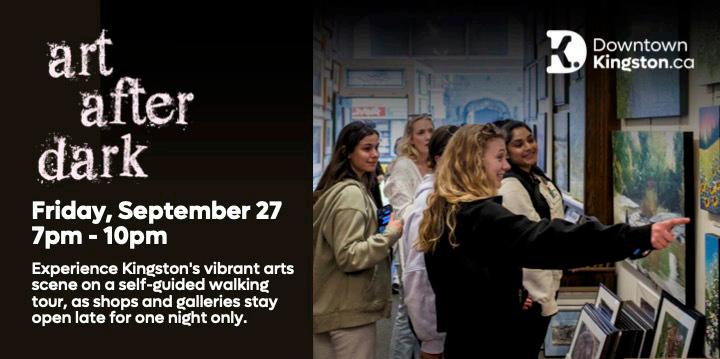
‘The Journal’ gets an inside perspective on what it’s like to try out for a Varsity program at Queen’s

Herbert Wang Assistant Sports Editor
On Queen’s campus, there are countless teams, clubs, and services to get involved in, no matter one’s interest.
For a large population, these interests are sports-related, whether it’s watching the Gaels, a professional league, playing them in intramurals, or casually.
For a smaller population, the goal is to make a Varsity team or club and play for the school they attend.
Unless you’re a part of the few with the talent to be recruited directly out of high school, for most, the journey to becoming a Varsity athlete begins with a tryout.
To learn more about this, The Journal spoke to Cross-Country coach, Mark Bomba, and Men’s Ultimate rookie, Augustin Benoit, ArtSci ’25 to get some insight into the process from both sides of the coin.
For Cross-Country, the process
Continued from the front page.
Among the other touchdown scorers for the Gaels were Nathan Falconi, ArtSci ’25, Jeremy Hiscox ArtSci ’26, who returned a fumble 19-yards to the endzone, Ethan Dahl ArtSci ’28, Keegan Vanek ArtSci ’25, who
involves training with the existing Varsity team for Coach Bomba to figure out who will be a good fit for the squad.
“We go through about a twoor three-week process to get an assessment and I generally find there’s two things that happen. We end up finding the kids who are a bit more serious and after those two or three weeks, we have the kids who peel off,” Bomba said.
For Men’s Ultimate, with a season that lasts for only a month and a half, the process become a bit more condensed.
“Tryouts will happen the first week of school of every year. […] This year it was three back-to-back days,” Benoit said in an interview with The Journal
“They really want to see your sports IQ, it’s such a short season, it’s only a month and a half. So, they want to know who already has a feel for the game,” Benoit added.
Despite the differences, the core concept remains the same. Tryouts
recorded a pick-six early in the third quarter, and Jayden GurziMacDonald, ArtSci ’28.
Kicker Tyler Mullan, ArtSci ’26, also recorded another stellar performance, knocking down two field goals, and converting on all of the extra points given to him.
It was a complete effort, both
give athletes a chance to prove themselves to coaches trying to build a winning squad.
For all sports, the spots on each team are limited and both have found that the number of athletes interested are increasing, while the roster sizes have remained the same.
“I think numbers last year, we had 80 people. This year, like over 100 and you could tell there was like 100. It was wild. Like a lot of good players too,” Benoit said.
Behind the scenes, it becomes a delicate juggling act that coaches are keenly aware of.
“I typically try and leave a bit of breath so we can carry up to 50 athletes. And I’m not going to lie to you, that’s when that can be a lot at certain times. He had 11 recruits, we had our normal varsity group, which was 46 athletes, and then we had about another 10 or 15 tryout athletes. So, we had like, probably like 70 kids out there,” Bomba emphasized.
For an athlete it presents the
offensively and defensively from the Gaels, capitalizing on the Gee-Gees’ offensive mistakes to return missed field goals, fumbles, and interceptions.
The Gaels’ next matchup is against the Guelph Gryphons; Head Coach Steve Snyder alluded to some of the challenges the team must
challenge of standing out from the crowd.
“It’s super cliche, but you may have buddies the year before. But come tryouts, you can’t be buddy buddy. […] My mentality is I don’t care until you make the team everything. Just because right now, you got to focus on yourself,” Benoit said.
It’s a common misconception that the best athlete will automatically make the team, however, coaches often weigh the pros and cons of ability and character when making their decisions. There’s a common adage that “the best ability is availability.” It’s often used in reference to injuries, but it’s also true when demonstrating character traits coaches look for.
“If we have an athlete […] for the personality traits, who’s willing to put in the time and willing to put in the work and, all of a sudden they find out, oh, I’m actually more talented than I thought it was,” Bomba said.
overcome when playing a team like Guelph, who has an identical record to the Gaels, so close to playoff time.
“Guelph is a really good football team, they’re off to a great start as well. They’re a team with an incredible running back group, a dynamic quarterback group and a very veteran defensive
In Benoit’s case, having been on the Ultimate B team for the past two years, he’s put in the work for two off seasons straight to make the team.
“Preparation starts mid-October. Like, as soon as the season’s done, you’re thinking, at least I am, and I think a lot of people do are thinking about the next year,” Benoit said. When tasked with putting in work, it’s easy to put pressure on yourself to make the team, however, Benoit added the importance of not letting your emotions play a factor.
“Don’t let your emotions get the better of you, because that’s not going to help you during selection either,” he added.
And once you’ve put in all the work, all you can do is hope.
“I ended up waking up at like 2 a.m. because I just couldn’t sleep. I checked and I saw I made the team,” Benoit said. “That was huge, but it was super rewarding and a crazy feeling. A lot of work goes into it.”
front.” Snyder said, “All the games we’re going to have playoff implications, and they’re all going to be against tough opponents, so this is a big one for sure.”
The Gaels return to Richardson Stadium on Sept. 21 at 3 p.m., make sure to get out and support our Gaels!

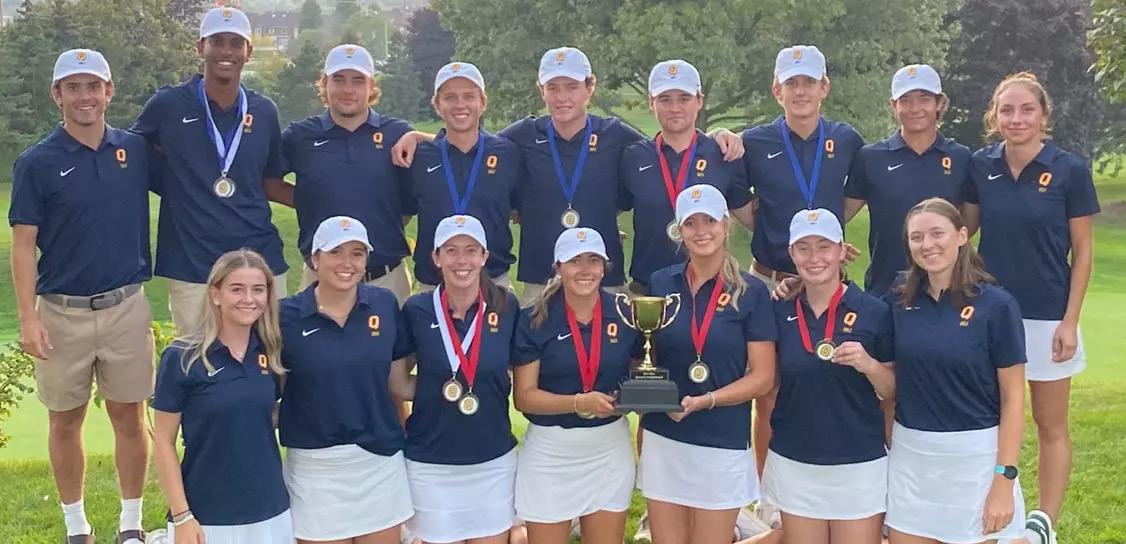
Gaels assert themselves as a powerhouse in OUA Golf circuit in memorial tournament
Aidan Michaelov Senior Sports Editor
The Gaels dominated at the Cataraqui Golf & Country Club on Sept. 15, with the Women’s Golf A team winning gold in the overall, and the Men’s A team winning silver in the overall. Both teams won individual medals as well.
The Bert Kea Invitational is a memorial tournament held in honour of the Head Coach of the Golf club at Queen’s from 2000 to 2017, Bert Kea.
Kea left a remarkable impact on the players he coached, with 91 student-athletes named Academic All-Stars during
Kea’s long tenure at the helm of Queen’s Golf.
It was quite the poetic turn of events for the Gaels at their legendary coach’s memorial tournament, with the Women’s A team, consisting of Kiley Rodrigues, Ed ’25, Katie Neville, Med ’26, Rachel Demaine, ArtSci ’25, and Marlow Slatter, Kin ’27, scoring a combined 235, which was 13 strokes above par, and 10 strokes better than the silver medalists, Laurier University. Individually, Rodrigues earned herself a gold medal, shooting a 74 (+2) in what was her first tournament as a Gael.
Neville followed close behind, shooting a 78 (+6) to secure a bronze medal.
On the Men’s side, Ryan Crowley, ArtSci ’25 recorded the lowest score of the day, shooting a 66 (-4), earning himself the gold medal. Daniel Abraha, Comm ’26, also had a good day on the links, scoring par with a 70.
While the Men’s team struck the ball well, Laurier ultimately edged them out by two strokes for the top spot, leaving the Gaels to take home the silver medal.
This tournament also marked the first appearance of new Head Coach Jessie Mercer
in tricolour. In an earlier interview with The Journal, Mercer emphasized the importance of the Gaels getting hot early and keeping them performing consistently, stating it will help build confidence going into some of the bigger tournaments.
“It’ll kind of set us up when we get to the national championship to have a few more events under our belt, a few more good memories to feed off and build momentum into those bigger championships,” Mercer said.
This was definitely a step in
the right direction for Queen’s Golf. Mercer also acknowledged the Gaels’ unmatched competitive fire, which she’s certain will carry them to success.
“Along with the girls, the men’s team have a very competitive fire,” she said. “Having conversations with them, it’s been really exciting to see how competitive they are, how excited they are for the season, and what they want to accomplish both individually and as a team..”
Aidan Michaelov Senior Sports Editor
After two preseason exhibition games for the Men’s Hockey team, I figured it was time to provide a grading of sorts to the Gaels: and delving into where they might end up at the end of the season, and who might be the next star for the Gaels.
On Sept. 7, the Gaels faced off in the Lou Jeffries Memorial Game against their historic rivals, the Royal Military College (RMC) Paladins.
By defeating the Paladins 5-2, the Gaels showed some serious promise, shutting down many questions surrounding how successful the Gaels might be amid the departure of star centerman Dalton Duhart, who left to play minor professional
hockey in Bloomington, Illinois.
Last season, Duhart recorded 44 points in just 28 games and was among the league’s most prominent scorers.
Derek Hamilton, ArtSci ’27, stepped up big time in what was our first look at this year’s Gaels roster.
Hamilton, who played on the wing last season, will finally return to his natural position of centerman following Duhart’s departure.
Coming off his rookie season and being named an OUA Rookie All-Star, scoring in the first exhibition game of the season, not to mention a rivalry game, is a promising start for a player who could make a huge impact down the line.
Another player who made a solid impact during preseason is Nolan Hutcheson,
ArtSci ’25. Hutcheson scored once against the Paladins and potted two more goals on Sept. 14 against the Windsor Lancers.
Regarding Hutcheson’s performance, it’s less of a shock that he seems to be gearing up for a monumental season.
Head Coach of the Men’s Hockey team, Brett Gibson, spoke highly of Hutcheson in an interview with The Journal, stating he thought the 6’4 Kingston native “is going to be an elite player in this league moving forward.”
This season, the Gaels are in an unfamiliar position when it comes to their goaltending.
Last season, there was much worry about the Gaels’ goaltending competence, stemming from poor performances
in the 2022-23 season.
Those worries were quickly put to rest, however, as Christian Purboo, ArtSci ’25, put up some solid numbers, asserting himself as a reliable option for the Gaels with a .930 save percentage and allowing just 1.94 goals per game.
Purboo had a statement game against the Paladins, offering up a sound foundation for him to build upon throughout the regular season, making 20 plus saves in the Lou Jeffries Memorial Game.
Against the Windsor Lancers, Aidan Spooner, Comm ’27, got the start, helping the Gaels secure a 4-3 win in Windsor.
Last season, Spooner split the eight games he played, winning four and losing four. While this isn’t enough
to say that he will be taking games from Purboo, the prospect of improvement which typically happens as goalies get more comfortable in their environment— suggests the team has two solid options for Head Coach Brett Gibson to turn to should he need.
Overall, it seems as though the departure of graduating players hasn’t knocked the Gaels off course too severely, and the 2024-25 campaign could shape up to be quite promising for the Men’s Hockey team.
The Gaels have four more exhibition games throughout September, with their next matchup being in Waterloo, where they’ll face off against the Laurier Golden Hawks on Sept. 19.


T he P sychic s cholar Staff Writer
Fall’s in the air, and so’s the scent of blossoming new relationships. This cuffing season promises plenty for the zodiac signs, with everything from genuine connections and sizzling chemistry to the ups and downs of love and heartbreak.
Whether you’re enjoying September in the arms of a special someone or finally giving in and downloading Tinder, get ready—it’s going to be an exciting few weeks ahead.

Libra (Sept. 23 – Oct. 22)
Happy Libra season! This is your time to shine, and everyone around you knows it. If you notice more people doing double-takes as they pass by you, don’t question it. Embrace the sexy side glances with strangers and let your newfound glow guide your heart, Libra.

Scorpio (Oct. 23 – Nov. 21)
You’re about to turn up the heat, Scorpio, so don’t be afraid to demand what you want. Make your intentions clear, your Tinder matches will appreciate it. Make this cuffing season unforgettable with moments as electrifying as you.

Sagittarius (Nov. 22 – Dec. 21)
Sagittarius, let your wild side take the spotlight. While you may have been called a serial dater in the past, your knack for flirting and small talk will serve you well. Keep things playful and enjoy the adventure of meeting new people. Don’t forget to have fun and stay true to your spontaneous self.

Capricorn (Dec. 22 – Jan. 19)
Don’t stress, Capricorn—you’ll coast through cuffing season. Your long-term relationship will
become stronger than ever, and if anything, your feelings will grow unbearably intense. Just remember to save some affection for the rest of us and keep your PDA out of the CoGro line!

Aquarius (Jan. 20 – Feb. 18)
Feeling confused, Aquarius?
You’re not alone, your friend-with-benefits is right there with you. What began as a casual hookup is suddenly turning into something deeper. Stay calm and remember honesty is your best friend (benefits not included).

Pisces (Feb. 19 – March 20)
Pisces, it’s time to get serious. You’ve been a heartbreaker for too long, and people are growing tired of it. This cuffing season, it’s time to settle down and leave the games behind. Show that you’re ready to embrace an emotional connection, beyond just bedroom chemistry.

Aries (March 21 – April 19)
Stay on guard, Aries. While dating around has been fun and harmless, a dose of reality is coming your way. You tend to trust quickly, which could come back to haunt you. Keep your standards high and your location turned “on,” bad dates happen but scary ones are avoidable.

Taurus (April 20 – May 20)
Good things are on the horizon, Taurus! You’ve been in a bit of a dry spell, but that cutie you’ve been messaging on Hinge seems like a real catch. Keep your mind and heart open, and don’t let your friends rush you, you’re moving at the perfect pace.


Gemini (May 21 – June 20)
Gemini, I have to be honest with you: your partner’s annoyance with you is more than just a small lovers’ spat. Prepare for some tough conversations over the next few weeks. It may feel like everything’s falling apart, but I assure you, you aren’t the first person to cry in the Stauffer lobby. There’ll be light at the end of the tunnel!

Cancer (June 21 – July 22)
Take a breather, Cancer. You finally shed yourself of that deadbeat, so embrace the newfound freedom. This cuffing season, I encourage you to fly solo. While all your roommates spend Friday nights on dates, enjoy having the house to yourself and learn to love being single.

Leo (July 23 – Aug. 22)
Leo, I suggest you keep your bed made, you never know who might end up in it after a night out or a late-night study session at Stauffer. It’s always better to be prepared, and let’s face it, first impressions count. Cuffing isn’t just for relationships, if you catch my drift.

Virgo (Aug. 23 – Sept. 22) Lay low, Virgo. Just like a full moon, cuffing season is bringing everyone’s exes out of the shadows. You’ve worked hard to find your peace, so don’t let it slip away. Block those numbers if you need to and keep your heart safeguarded.

Cherishing community is at the heart of McFadden’s music
Madison
taylor Senior Arts & Culture Editor
There’s no rulebook for processing grief, but Sadie McFadden’s upcoming song might offer a salve for some.
Queen’s alumna Sadie McFadden, ArtSci ’22, BEd ’24, is a key figure in the Kingston music scene. Wrapping up an Ontario-wide solo tour after completing her second degree, McFadden is set to release her newest single “Grieve at 23” on Oct. 3. The song explores McFadden’s journey with grief, after the passing of her mentor, Suzanne Pasternak, in 2023.
A musician who values community connection within her art, this latest single is the first of many more tracks she hopes to release soon.
During her time at Queen’s and beyond, McFadden has revelled in connecting with the music community in Kingston. From organizing an open mic night at CoGro this summer, being a member of the Queen’s Music Club, participating in Muse Tiny Desk, and working at CFRC, this connection with Kingston creatives has remained strong both in, and out, of university life.
“I feel like I’ve always tried to like create spaces for creating, to use it in a communal setting, you know? Community is very central to what I’m doing,” McFadden said in an interview with The Journal.

Taking a year off between her two degrees, McFadden used this time to figure out how to balance her two paths. After her successful run as the lead singer for band Hinterwood, McFadden decided to shift the focus onto her solo career.
“That was kind of a decision I made on my year off [...] I was also emergency supply teaching on the school board here. I decided - wow, I really enjoy teaching - and it also works really well with being a musician. So, I went back to school for it,” McFadden said in an interview with The Journal
She used her free time this August to tour around Ontario, gaining valuable experience along the way.
“After I finished my Bachelor of Education, I just decided to take the last month and a half playing everywhere.
It’s been an incredible experience, and I’ve been
really appreciative for all of my friends and family and fans that have come out and been so supportive of my music. It’s been a great opportunity to try out new things,” McFadden said.
From an impromptu jam-style performance with JUNO award winning jazz musicians, selling out her hometown show in Hamilton, and making unexpected connections along the way, McFadden’s tour has been a success.
With a variety of musical influences, ranging from choir singing in childhood, a high school love of rap, and inspirations from rock and blues, McFadden’s soulful voice has now settled on a sound she describes as “folk-pop-rock.”
McFadden’s upcoming single deals with the difficulties of grief, and was inspired by the loss of her mentor figure, Suzanne Pasternak. Pasternak was a close figure in McFadden’s
life, musically and otherwise. Pasternak also introduced her to Kingston musician Miss Emily who continues to play a big role in McFadden’s life.
The two established artists were influential in McFadden’s development as an artist.
“They really taught me not to put up with sh — t, and to recognize my value as a female artist. I think that’s very important, and they just make me feel so powerful as a woman,” McFadden said.
McFadden’s upcoming song “Grieve at 23” explores the complexities of this sudden loss.
“It weighed really, really heavily on me. And so, I just needed to get it out in this song,” McFadden said.
“This song is kind of like me pleading to understand how to experience this.” McFadden said. “I want to live my life as beautifully as she has.”
McFadden’s next focus is recording and releasing more music after her recent string of shows. She has high hopes for her next records, hoping to record her song “Fallen,” soon at Port William Sound.
With a focus on community and connection woven into the fabric of her music, McFadden hopes “Grieve at 23” will resonate with those living through loss.
Interested in writing for The Journal? Email journal_editors@ams.queensu.ca for more information. No experience is necessary.
Eva Sheahan Assistant Arts & Culture Editor
After the success of CFRC’s Airwave YGKDJArtists-in-ResidenceProgram last school year, CFRC 101.9 FM is expanding its programming to young musicians through its Airwave YGK Musicians-In-Residence program.
The Airwave YGK MusiciansIn-Residence program will invite emerging musicians and bands to use the station’s studios for a two-to-three-day residency, where they can perform live on air with CFRC, have access to technical support and professional advice, undertake an artist interview, and promote upcoming releases. Residents will receive an honorarium of $400 for their work, funded by the City of Kingston andKingston Arts Council. Applications open this month and are due on Sept. 30.
The goal of the new Airwave YGK Musiciansin-Residence Program is to provide opportunities for musicians here on campus to perform for CFRC’s 29, 000 weekly listeners. This residency aims to help new musicians create their art, receive advice from local industry professionals, and form industry connections to kick off their musical careers.
Continued online at www.queensjournal.ca

Luca Guadagnino’s ‘new film ‘Queer’ reaffirms why he’s such an interesting director to watch
Luc Lafontaine Contributor
Luca Guadagnino’s latest film Queer explores the way love can quickly turn into obsession.
Queer is adapted from William S. Burroughs’ novel of the same name. Screening from Sept. 12 to 15 at the 49th Toronto International Film Festival (TIFF) this year, the film follows William Lee, played by Daniel Craig, who’s an American living in 1950s Mexico City. Lee becomes obsessed with a man named Eugene Allerton, played by Drew Starkey. Lee tries to get closer with Allerton, while also trying to figure out if Allerton is gay.
Queer reinforces why Guadagnino is such an interesting director to watch. In his films, Guadagnino is always experimenting with new ways to visualize emotions on screen. Guadagnino’s experiments with visuals and editing are not merely gimmicks, they’re insights into the characters and their mental states. For example, at certain points, we get glimpses of Lee’s subconscious desires on screen by layering his uninhibited self overtop of what’s really happening in the scene.
What makes Guadagnino’s style truly great is that his unique
presentation enhances the story being told. In Queer, Guadagnino plays with subjectivity. The film is grounded in Lee’s perspective, and everything we learn about Allerton is through Lee’s eyes. This subjective lens shows both the excitement of getting closer to someone, as well as the dangers of putting a lover on a pedestal.
This film features what’s possibly Daniel Craig’s best performance to date. While we can’t see all of Lee’s thoughts as in the novel, with Craig’s layered performance, we don’t need to. Near the beginning of the film, we watch Lee desperately search for any sign that Allerton likes him back. Lee’s need for validation is clear as day, as he spirals at the first hint of rejection. Craig also brings a dry sense of humour to what’s otherwise a drama.
While this is the second collaboration between Guadagnino and screenwriter Justin Kuritzkes after Challengers, released in cinemas earlier this year, by no means is it similar in tone to their most recent work.
Guadagnino and Kuritzkes excel at showing the subtleties of a deeply unhealthy relationship through Lee and Allerton. In Guadagnino films, small actions create big moments. A quick glance or touch are huge turning points for the characters.
The film very clearly juxtaposes Lee’s obsession with Allerton with Lee’s addiction to drugs. As Lee searches for both an experimental drug, and for connection with Allerton, he starts to be consumed by both of his obsessions.
For much of the 135-minute runtime, Queer makes you think you’re watching a slow-burn romance like Guadagnino’s film Call Me by Your Name, but it morphs into something darker, more similar in tone to his films Bones & All and Suspiria.
The result of this dramatic tonal shift is a finale that’s surreal, horrifying, and beautiful all at once. The film’s bright colours are replaced with disturbing imagery, demonstrating Guadagnino’s wide range as a filmmaker and his ability to pivot from one tone to another, all while maintaining a coherent vision for the film and its themes.
If there’s one through- line in Guadagnino and Kuritzkes’ collaborations, it’s the power of love, for better and for worse. In Challengers, love is a game. In Queer, love is an addiction.
Queer shows why Guadagnino is such a strong filmmaker, while also demonstrating a clear evolution of his style. A theatrical release date has yet to be announced.
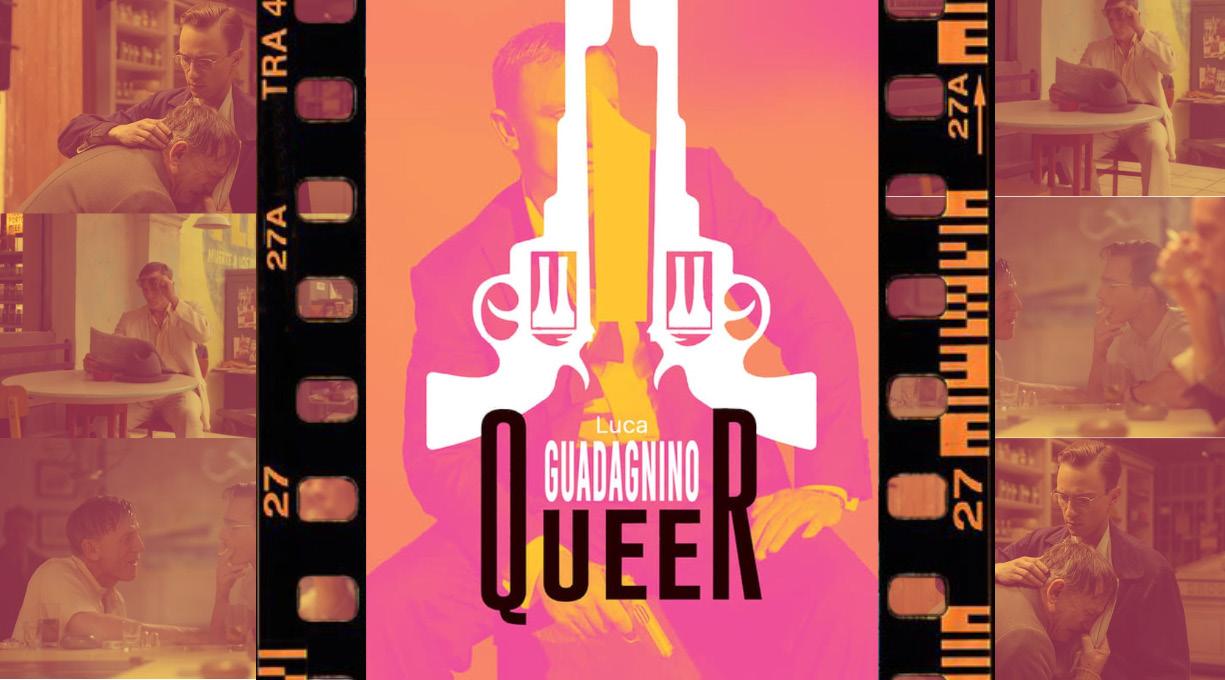
Dutcher makes history as the first person to win the prestigious award twice
Madison Taylor
Senior Arts & Culture Editor
It was a starry night for Jeremy Dutcher at the 2024 Polaris Music Prize Gala.
The Polaris Music Prize, established in 2005, is a not-forprofit registered charity that awards a $50,000 prize to the best Canadian album of the year, regardless of sales, label, or genre. On Sept. 18, at the annual Polaris Gala at Toronto’s Massey Hall, Jeremy Dutcher won this year’s award.
Dutcher first won the prize in 2018 for his album Wolastoqiyik Lintuwakonawa, and woins again this year for Motewolonuwok. He makes history as the first musician to win the award twice.
Dutcher is a Wolastoqiyik member of the Tobique First Nation, and preserving and uplifting the Wolasoqey language is crucial to his work. In Motewolonuwok, his second record, Dutcher included English lyrics for the first time, alongside Wolasoqey.

FRom liz, with love: i Caught my best FRiend Cheating on heR boyFRiend…
You’re caught in the middle because your best friend crossed the line, now what?
elizabeth provost Copy Editor
Dear Liz,
Last weekend, I caught my best friend cheating on her boyfriend. She told me she was going to catch up with a friend, but later when I was walking by the pier, I saw her and one of our mutual guy friends practically lying on top of each other on a beach towel. At first, I thought I was seeing things, but I observed for a bit (I know, creepy) and it was definitely them. I’m having a hard time bringing it up to her. She’s told me she was having problems with her boyfriend, suspecting he was cheating... Not that that makes this behaviour excusable. I find it especially hurtful because I recently got cheated on and she was so comforting. Do I approach her about it? Am I allowed to be angry or is it none of my business? Is this worth losing the friendship over?
Signed, Shocked and Confused
Dear Shocked and Confused,
Wow, what a whirlwind.
Catching your best friend in a moment like that—especially when you’ve been on the receiving end of cheating yourself—must have felt like a punch in the gut. You’re not just dealing with being blindsided, but also the weight of her actions hitting close to home. It’s no wonder you’re feeling hurt and confused.
First, yes, you’re allowed to feel angry. Even though it’s your friend’s relationship, you trusted her in your moment of hurt, and seeing her repeat what broke
Currently on a Canada-wide tour with intermittent shows across the country, Dutcher is set to performs in Queen’s’ own Isabel Bader Centre for the Performing Arts on Sept. 20.
The show will be held in Jennifer Velva Bernstein Performance Hall, as one of the Isabel’s Artists Spotlight Concerts. He moves on to Vancouver and Halifax throughout October.
The award is judged by an 11 member Polaris Grand Jury, selected from a wider juror pool. The prize aims to uplift
and celebrate the art of music and acknowledges its role in shaping the Canadian music canon.
With the winner chosen from 40 long list nominees, and 10 short list nominees, the competition is stiff, with many great Canadian musicians up for the prize. This year’s short list included Allison Russell, BAMBII, Charlotte Cardin, Cindy Lee, DijahSB, Elisapie, NOBRO, The Beaches, and TOBi. These artists span many different languages, genres, and
you to bits can feel like a breach of that trust. But before jumping to any conclusions, it’s important to talk to her. Approach her with empathy and curiosity rather than judgment. After all, you don’t know the full story—there could be complexities in her relationship you aren’t privy to.
Relationships can be messy, and many people choose to keep how they approach them to themselves. Although her response may not excuse her actions, if they are what they seem, it might help you understand her motivations better.
When you do talk to her, focus on how her actions made you feel, rather than accusing her. For example, you could say, “I saw you at the pier, and it really upset me, especially given everything I’ve been through. Can you help me understand what’s going on?” This opens the door for an honest conversation without putting her on the defensive.
Now, is this worth losing a friendship over? That’s something only you can decide. It depends on how she responds to your honesty and how you feel about her actions going forward. If she takes responsibility and shows remorse, there might be room to move forward. But if she denies or dismisses your concerns, you may have to reevaluate your boundaries.
Ultimately, your priority should be protecting your own peace and values. Friendships can survive difficult conversations, but they can’t survive a lack of trust.
With love, Liz
locations across the country, showing the diversity of the prize.
Previous winners of the prize include familiar names such as Kaytranada, Buffy Sainte-Marie, Feist, Arcade Fire, and Caribou.
Dutcher was presented the prize by 2023’s winner, Debby Friday.
Continued online at www.queensjournal.ca
Eva sheahan Assistant Arts & Culture Editor
Reducing female friendships to the label of being a “girl’s girl” upholds a shallow version of feminism that promotes the objectification of women, actively upholding the patriarchy.
I first came across the term “girl’s girl” on TikTok in 2023, where the idea seemed well-intentioned. The root of the idea is for women to support one another—it celebrates female friendships, helping your girlfriends look good in front of their male crush, and telling a man’s girlfriend if he flirts with you. While the idea has good intentions, and celebrates connections between women, men still, somehow, take centre stage.
If you don’t do these things, like failing to fix your friend’s lipstick in front of a hot guy during a night out, or not giving your friend's number to her crush at a party, you’re considered not a “girl’s girl.” Instead, you risk becoming the dreaded “pick me.” The definition of a “pick me” is someone who rejects typical “feminine” traits to receive male attention and validation by virtue of being “not like other girls.”
Feminist author Dolly Alderton once wrote, “nearly everything I know about love, I’ve learnt from long-term friendships with women.” When I read these words,
It’s time we exclude the male gaze from female friendships
I was instantly inspired, as I value my friendships with women so deeply. It’s through these friendships that I feel truly myself.
Yet, I’ve always hesitated to call myself a “girl’s girl.” The label offers such an oversimplified,
you to critically examine when the term is used and what it truly means to feminism. Continuing to acknowledge the intricacies of identities, femininity and friendships between women can be completely removed from
that promotes capitalism and overconsumption. It’s a way to encourage women’s so-called power through money, looking good, and individualism.
Movements like “Lipstick Feminism,” a branch of Third

watered-down rendition of female friendships and femininity. It assesses and measures female friendships through an attachment to men. For instance, you’re the ultimate “girl’s girl” if you help your friends to be as attractive as possible, judged on the metric of male validation.
While it’s tempting to use the term “girl’s girl” lightly, I invite
involving the realm of men. They’re more complex than the confines of internet slang.
If women continue to assess feminist behaviour in relation to men, as we do with the “girl’s girl” character, patriarchal values will continue to be upheld.
This addition of “girl’s girl” to the cultural vocabulary, is a direct result of Third Wave feminism
Wave feminism, align with the trend, subtly promoting concepts that oppress women through overconsumption and places an emphasis on appearance and money. The “girl’s girl” concept only furthers this narrative, by contributing to superficial ideas that appear empowering while continuing to shackle women with the patriarchy.
Encouraging a shallow feminist approach promotes the objectification of women and doesn’t address the social issues women face. This version of feminism doesn’t achieve true liberation. Instead, it pits women against one another, vying for status through male validation.
TikTok is partially responsible for pushing these superficial narratives, like the “girl’s girl”, onto its impressionable audience. Experiencing feminism and womanhood as a collective can be difficult when capitalism thrives off individualism. If women are encouraged through consumer culture to feel empowered through shallow concepts, glam, and incessant shopping, feminism may meet a bleak fate.
Feminists can’t oversimplify nuanced issues of gender oppression and inequality the way the “girl’s girl” does. Our feminism must extend beyond calling other women pretty—that’s not enough for liberation.
To reach true emancipation from the patriarchy, women must encourage intersectional and diverse feminism to come together as a cohesive group, waving goodbye to the “girl’s girl” and leaving the male gaze out of discussions of female friendships.
Some touring musicians are committed to the climate, while others aren’t, and it shows
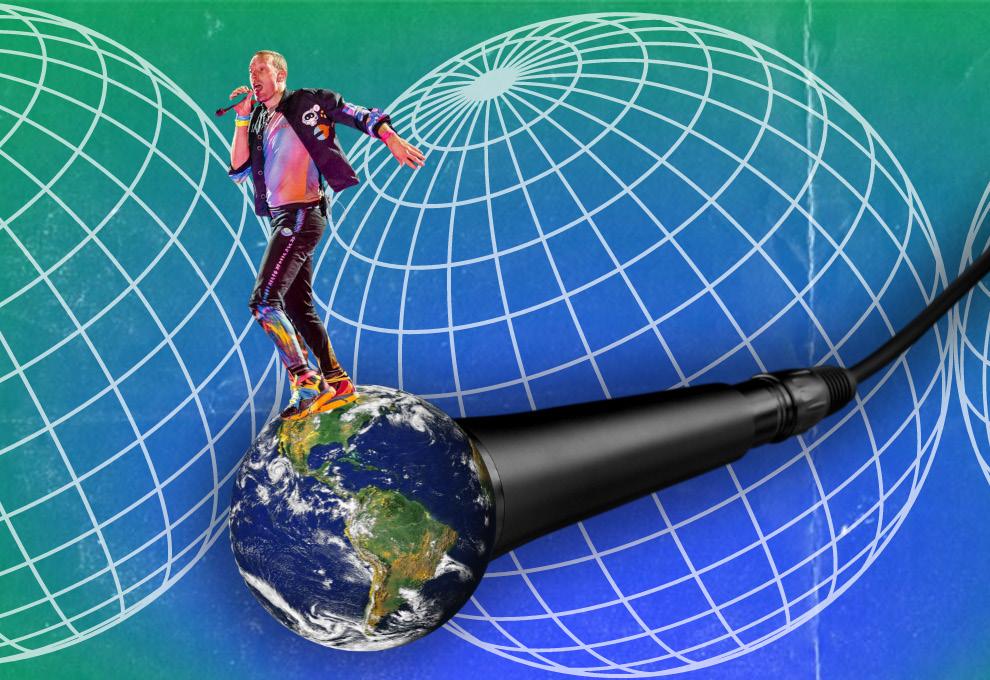
Madison Taylor Senior Arts & Culture Editor
Some touring musicians take their impact on the planet more seriously than others, and it shows.
A troubling side effect plagues the profession of the internationally touring artist: the environmental impact associated with such frequent travel. It's the subject of much discussion online, from memes poking fun at Taylor Swift’s excessive private jet use, to Coldplay’s recent tour with a focus on offsetting the emissions they create. Artists are on opposite ends
of the spectrum when it comes to addressing this issue. The industry standard may be on the brink of change, but only if its biggest players, and their audiences, take a stand.
This conversation about the environmental ethics of touring musicians gained international attention with Coldplay’s “Music of the Spheres” world tour, which kicked off in March 2022. Through multiple sustainability initiatives, the group has produced 59 per cent fewer CO2 emissions than their “A Head Full of Dreams” stadium tour in 2016. Other impressive metrics, such as planting one tree for every
ticket sold, can be seen in their extensive sustainability report, updated in June.
Their drastic action comes at a critical time. Within the United Kingdom alone, musicrelated tours account for 850,000 tonnes of greenhouse gas emissions per year.
Other artists have echoed Coldplay’s calls for sustainable practices in the music industry. Musicians who have also altered their touring practices to reduce their environmental impact include Billie Eilish, Dave Matthews Band, Jack Johnson, and AJR, among others.
As well as taking steps to reduce the impact of their own touring practices, some artists have decided to use their influence to encourage fans to take environmental action.
AJR frontman Adam Met, who has a PhD in international human rights law, recently founded Planet Reimagined, a non-profit organization. One of their key initiatives, “Amplify,” focuses on the way musicians “can serve as much needed climate messengers” by using their platform to encourage fans to act. AJR adopted this practice during their most recent tour.
However, at the opposite end of the spectrum, Taylor Swift’s recent worldwide “Era’s” Tour has sparked online controversy for its negative impact on the environment due to the star’s excessive use of private jets. University student Jack Sweeney, who tracks Swift’s air routes and posts their emissions and fuel use online, recently received a ceaseand-desist from the star’s team, even though the information was already public.
This topic has become the butt of many online jokes at Swift’s expense, with quips that she uses her jet to travel to locations as close as the grocery store. Though hyperbolic, they raise valid environmental concerns regarding musicians’ touring practices.
Though some argue an artist’s celebrity status impinges
on their ability to travel freely without harassment—making private jet use a common and safer option—there are other ways their carbon footprint can be reduced.
Billie Eilish, a star with a level of fame comparable to Swift, helped launch and fund REVERB’s Music Decarbonization Project, which aims to eliminate carbon emissions created by the music industry.
It’s unclear where this leaves the industry standard for musicians. Many fans are quick to call out unsustainable practices, yet artists’ shows remain well attended. This environmental concern may not be enough to quell the desire of seeing one’s favourite musician perform live.
Power ultimately lies with concertgoers, who can vote with their attendance, and their dollar. The industry norm is unlikely to change without audience pressure. By filling stadiums, these unsustainable practices are affirmed and allowed.
However, change from within the industry is also necessary. As huge stars like Eilish, and Coldplay have shown, more sustainable practices can be adopted without sacrificing fan attendance, and ultimately profit. If these artists can do it, then so can others. Touring musicians’ impact on the environment is a by-product of the job. The way different artists tackle this issue shows their true colours when it comes to addressing the climate crisis.
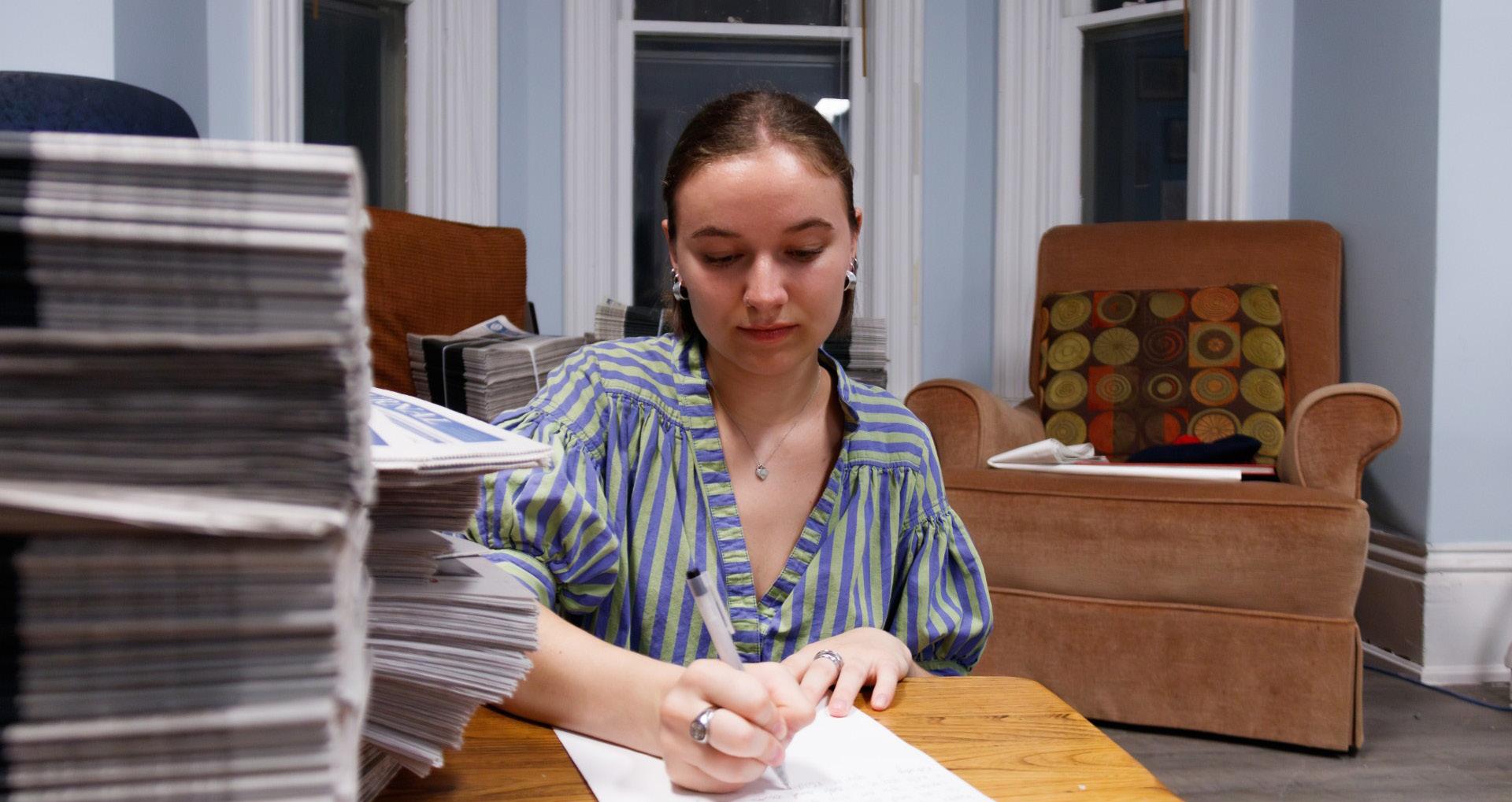
A letter to my first-year self
Cordelia Jamieson
QTBIPOC Advisory Board
Member
Hi Cordelia, Three years at Queen’s down, one to go, and I have so much to fill you in on.
For starters, most people call you Cordy now. And, before you ask, you’re still big on Dolly Parton, grew to love Kingston, took up hot yoga, still can’t cook, and finally saw Mt. Joy in concert.
As we head into our fourth and final year, I have so many stories and pointers to share in the spirit of navigating new friendships, exploring ever-changing family dynamics, discovering the ups and downs of dating in early adulthood, balancing coursework, and job-hunting.
Let’s review, Dolly Alderton style.
Friendship
Good news, first-year Cordelia, you only need to wait two and a half days to meet your future friend. You’ll walk to Richardson Stadium together during orientation weekend because you’ll both sleep through your alarms. You’ll then bump into her again in a mutual friend’s Victoria Hall dorm room, think she’s kind of weird, and spend the next year and a half engaging only in small talk. A reconnection at an Alzheimer’s-themed trivia night will lead to an epic evening belting karaoke, and a walk home where you’ll laugh so hard your ribs hurt.
you’ve ever had—and realize she’s one of the brightest things to come out of your experience at Queen’s. It takes time, but it is so worth it. Allie is kind, considerate, so ridiculously intelligent, inspiring, and a dope person to have in your corner.
Spoiler alert, you also reconnect with a friend from summer camp and spend the next three years living under the same roof.
Layla is compassionate, smart, your primary source of hysterical humour, your go-to for rational advice, thoughtful, and in bed by 11 every night. She has taught us so much about letting go, harbouring peace, and cooking tofu. I’m confident, now more than ever, that you’ll soon fulfill your 15-year-old-selves’ dream-day of getting two for $15 piercings at a parlour called “Wizards” before camping out at an EDM festival in Montreal.

Family
Quarantining under one roof with your parents and siblings didn’t exactly do wonders for those relationships; it made you all moody and far too sensitive. Moving away now will make visits home all that more special and having a closet 272 kilometres away from your sister’s eliminates a number of clothes “borrowing”- related tussles. The distance unfortunately means you’ll have to kiss your favourite top of hers goodbye, but you can’t win them all.
holiday catch-ups are always loaded, and FaceTime is a truly phenomenal invention.
Your homesick tears will water the seeds of your dreams. I promise they aren’t mad at you for leaving.
Dating
Admittedly, I don’t have much wise advice to bestow here, because I’m just as far from success in this domain as you are. I can, however, say for certain the next three years of your life are full of ups and downs that teach you so much about your relationships with yourself and others.

appreciate: I promise you’ll have more fun at a puzzle-assembling wine night with friends than you will waiting in the Stages line without a jacket in January. That’s not intended in any way to dissuade you from going out, fourth-year you loves sucking on lollipops from the corner store at Barrie St. and Earl St. while waiting in line, dancing like a lunatic, and stopping at Pizza Studio for extra cheese and pesto mayo on the way home.
a pension plan, incomprehensibly intelligent coworkers, and the fact that we’d do it for free if they asked us to is a delightful bonus.
From stepping foot in your dorm room in 2021 to kicking off fourth year in 2024, you’ll work as a lifeguard, bartender, scientific study participant, barista, research assistant, summer camp counselor, healthcare aide, and intern.
You now share all of your secrets—and every other thought
Be warned, things change. In first year, you lose a family member. It sucks. In the summer before third and fourth year, your immediate family grows. Being far from home while things continue to change is tough, but unconventional love doesn’t recognize distance—
You fall in love, and then fall back out. As special as that relationship is, and as much as it’ll sting when it ends, it is for the best. Great news though, I can confirm you’re capable of love and know you’ll find it again.
This part’s important, so pay close attention: do not, I repeat, do not, let your partner sully decisions you’re contemplating. If you want to go on exchange, go. If you’re feeling an impending career change, explore that. If you’re looking at grad schools far from home, apply. You are the person you spend the most amount of time with, and it would be a shame to let your partner steer you away from things that matter simply because they’re your partner.
You value good conversation, someone who likes cheese as much as you do, kindness, and a partner as fascinated by seeing the world as you are. It’s unfortunate you’ll have to have your heart broken to realize this, but I’m sure they’ll come in handy again, nonetheless.
Going Out
Here’s a piece of unsolicited advice you’re undoubtedly too naïve to
Going out also serves a lovely reminder to renew your driver’s license on time. Check up on that—going to Dollar Beers on a Saturday night with your passport hanging out of your back pocket isn’t as cool as you think it is.
This’ll be brief. Your minor selection won’t be a mistake, take classes that make you excited to show up on Friday mornings at 8:30 a.m., and please read Rate My Professor reviews before solidifying your SOLUS shopping cart.
Fourth-year me also thanks first-, second-, and third-year you for taking summer classes when the opportunity presented itself. Getting fun and departmentally assorted electives out of the way before the school year started is the only reason I currently take two classes

You’ll have bad bosses, coworkers that became great friends (and significant others, but I really don’t recommend it), rude customers, mind-boggling assignments, a number of awesome corporate outfits, good days, and obviously some bad ones sprinkled in here and there. The people skills you’ll refine as a bartender will come in handy in administrative meetings and your experiences at the health clinic will make you so much more equipped to handle corporate crises that pop up unexpectedly at work. ***
Cordelia, you’re so lucky. Lucky to be young and alive and lucky to have a home to come back to, even when it changes (and especially when it does). You’re lucky to learn, lucky to love, and lucky to be. Things aren’t always light and breezy, but you’re lucky to live the days you do.
You are loving, loved, kind, brilliant, capable, and have an iron-clad network of friends and family who would move mountains to see you smile. Four years fly by and, on the dawn of beginning the last one, I’m already nostalgic for something that has yet to be over.
Soak it all up and enjoy it while it lasts. Also, you seriously don’t have to be so stingy with your TAMs.
I love you now, forever, and always.
